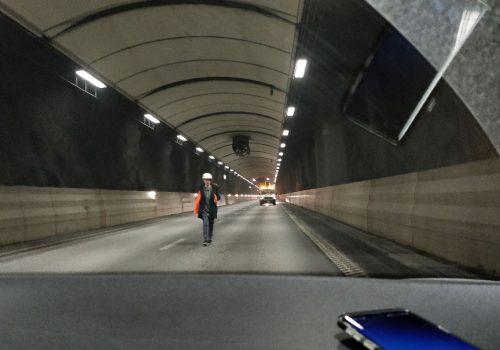Beyond the obvious benefits of letting drivers inside the tunnel get GPS signal to guide themselves, Trafikverket aims to improve the safety of all users. The main use cases are precise positioning of slow cleaning road cars, isolated workers, maintenance operators, basically any kind of emergency call location, and of course rescue forces guidance. This is achieved through the SubWAVE Continuous system implementation, currently being at least 5 meters accurate. The shape of a road tunnel is perfect to deploy a SubWAVE Continuous system, since targets to be positioned move up and down an axis, and not across. This calibration was the last step of deploying this accessible-by-all positioning solution.
SubWAVE GPS Coverage Extension solution often relies on existing telecom infrastructures. Indeed, leaky feeders deployed underground cover every inch of space to allow TETRA communication systems to work. Syntony’s SubWAVE devices are “simply” plugged in. As GPS signal uses a different frequency bands as radio does and as signal power is much weaker, there is no risk of interferences.
To ensure GPS continuity, and avoid equipment jumping between the outside and underground positions, SubWAVE+, (SubWAVE Continuous mode) must be calibrated at specific points of every leaky feeder.
Until now, this operation could be complex: authorizations to get in the tunnel, planification of interventions (sometimes during night shifts, etc.).
Therefore, remote calibration allows to save precious time: only technical worktime remains. Since every tunnel is unique, this bespoke installation time varies on a few factors: type of leaky feeders, their length and need (or not) to install injections boxes to solve natural signal attenuation, etc.
Piloting the operation from his laptop in Paris, Aurélien KORSAKISSOK, Head of Global Deployment, monitored and executed every step of the process. On site, client’s integration engineer drove and walked along the leaky feeder, with a standard uBlox GPS receiver connected to a laptop equipped with our SubWAVE Manager app. Remotely monitoring the integrator ‘s laptop, it became possible to make the calibration with no need of being physically on site. Instructions were told to the integration engineer via phone, whilst calibration is made through a monitoring desktop app. Adjusting the signal delay, its power, and last but not least, its coherence with the real position coordinates (in order to provide a fluid navigation to everyone ) in real time. This has now become possible to achieve remotely!
Based on a preliminary visit of the tunnel to check all parameters, we could achieve a 3 hours calibration remotely, (which should have lasted 5 to 6 hours on-site)!
Indeed, total length of leaky to be calibrated is numbered with kilometers, and therefore may take a while.
A major step is taken to get closer to fully automated calibration.
For precious lives, time and even money savings: Learn more about SubWAVE solutions on this page and discover in detail how SubWAVE works in our Fire Protection & Safety in Tunnels Conference talk!
